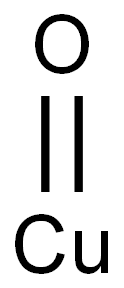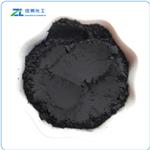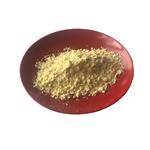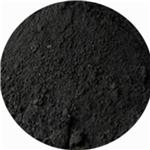Description
Copper (II) oxide is used for blue-green pigmentation in ceramics. As a naturally occurring compound produced from mining, it is also used as a precursor to other cooper applications, including fungicide and wood preservatives. In this capacity, it is used as an antifouling paint agent for boat hulls, and other outdoor, freshwater, and seawater wood constructions. It is also occasionally used for animal feed, but incorrectly, as its copper bioavailability is inferior to of a number of other compounds including cupric acetate and alkaline Cu carbonate. Other uses include preparation of superconductors, manufacture of batteries, and as a catalyst for various industrial processes.
Chemical properties
Black monoclinic crystal or black to brown-black amorphous crystalline powder; Insoluble in water and alcohol; soluble in dilute acid, ammonium chloride, ammonium carbonate and potassium cyanide.
Uses
Copper(II) oxide is used as pigments for coloring glass, ceramics, porcelain and artificial gems; in batteries and electrodes; in antifouling paints; in electroplating; in welding fluxes for bronze; in the production of rayons; for removal of sulfur from oils; in phosphor mixtures; for polishing optical glass; and as a catalyst. It also is used to prepare various copper compounds.
Copper(II) oxide is found in nature as the minerals tenorite and paramelaconite. They differ in crystalline structure: tenorite exists as triclinic crystals while paramelaconite consists of tetrahedral cubic crystals.
Uses
1. Cupric oxide Can Used for glass, porcelain colorants, oil desulfurization agent, hydrogenation agent, organic synthesis catalyst, and also used in the manufacture of rayon, gas analysis, etc.
2. Used as analytical reagent (for nitrogen determination), oxidant and catalyst.
3. Used for the coloring agents in glass, enamel and ceramic industry, the anti-wrinkle agents of paint and the polish of optical glass. Used in the manufacture of dyes, organic catalyst carriers and copper compounds. Also used in the manufacture of artificial silk and oil desulfurization agents. Used as the raw materials of other nantokites and artificial gemstones.
4. Used as the pigments of glass and porcelain, desulfurization agents, catalysts, and also used in rayon industry
5. Used for the determination of carbon compounds in organic compounds
6. Used as analytical reagents, oxidants, catalysts and petroleum desulfurizers.
7. Cupric oxide Can used for the coloring agents in glass, enamel and ceramic industry, the anti-wrinkle agents of paint and the polish of optical glass. Used in the manufacture of dyes, organic catalyst carriers and copper compounds. Also used in the manufacture of artificial silk and oil desulfurization agents. Used as the raw materials of other nantokites and artificial gemstones.
8. Used for blue green pigments, artificial gemstones, colored glass, ceramic glaze, oil desulfurization agents and organic synthesis catalysts, as well as for the carbon determination in gas analysis. The applications of Nano-copper oxide: (1) as an important inorganic material, it has a wide range of applications in the catalytic, superconducting, ceramics and other fields; (2) used as catalyst , catalyst carrier and electrode active material;(3) used for the colorants of glass and porcelain, the polishing agents of optical glass, organic synthesis catalysts, oil desulfurization agents and hydrogenation agents;(4) used for the manufacture of artificial gemstones and other copper oxides;(5) used for rayon manufacture, gas analysis and organic compounds determination;(6) used as the burning rate catalyst of rocket propellant. Nano-copper oxide powder has more excellent catalytic activity and selectivity than the large-sized copper oxide powder.
Toxicity
see cuprous oxide.
Production methods
1. Copper powder oxidation method. Reaction equation:
4Cu + O2 → 2Cu2O
2Cu2O + 2O2 → 4CuO
CuO + H2SO4 → CuSO4 + H2O
CuSO4 + Fe → FeSO4 + Cu↓
2Cu + O2 → 2CuO
Operating methods: roast the raw materials of copper ash and copper slag, and then heat them with gas for the initial oxidation to remove the water and organic impurities in raw materials. The resulting primary oxides are naturally cooled, pulverized, and then subjected to secondary oxidation to obtain crude copper oxides. Add crude copper oxides to the reactor pre-loaded 1: 1 sulfuric acid, and react under heating and stirring until the relative density of the liquid doubles and the pH value becomes 2 to 3. After the generated copper sulfate solution stands until clarification, add iron shavings under heating and stirring conditions to replace copper, and then wash the mixture with hot water to remove sulfate and iron. After centrifugal separation and drying, the above copper is oxidized and roasted for 8 hours at 450℃. Then the crude products are cooled and crushed to 100 mesh. After oxidized in oxidizing furnace, the final copper oxide powders are obtained by centrifugal separation.
2. Copper powder oxidization method:
roast the raw materials of copper ash and copper slag, and then heat them with gas for the initial oxidation to remove the water and organic impurities in raw materials. The resulting primary oxides are naturally cooled, pulverized, and then subjected to secondary oxidation to obtain crude copper oxides. Add crude copper oxides to the reactor pre-loaded 1: 1 sulfuric acid, and react under heating and stirring until the relative density of the liquid doubles and the pH value becomes 2 to 3. After the generated copper sulfate solution stands until clarification, add iron shavings under heating and stirring conditions to replace copper, and then wash the mixture with hot water to remove sulfate and iron. After centrifugal separation and drying, the above copper is oxidized and roasted for 8 hours at 450℃. Then the crude products are cooled and crushed to 100 mesh. After oxidized in oxidizing furnace, the final copper oxide powders are obtained.
4Cu+O2→2Cu2O
Cu2O+0.5O2→2CuO
Cu0+H2S04→CuSO4+H2O
CuSO4+Fe→FeSO4+Cu↓
2Cu+O2→2CuO
Hazards & Safety Information
Category : Toxic substances
Toxicity classification : high toxicity
Acute toxicity : Oral-rat LD50 470 mg/kg; celiac-mouse LD50: 273 mg/kg
Flammability Hazardous properties :
Non-combustible; producing toxic copper-containing fumes in fire
Storage and transportation characteristics :
Storehouse should be low-temperature, well-ventilated and dry; stored separately with food and raw materials
Fire extinguishing agent : water, carbon dioxide, dry powder, sand
Sources
http://www.encyclopedia.com/science/academic-and-educational-journals/copperii-oxide
http://jn.nutrition.org/content/129/12/2278.short
https://en.wikipedia.org/wiki/Copper(II)_oxide
Description
Copper(II) oxide or cupric oxide is an inorganic compound with the formula CuO. A black solid, it is one of the two stable oxides of copper, the other being Cu2O or copper(I) oxide (cuprous oxide). As a mineral, it is known as tenorite. It is a product of copper mining and the precursor to many other copper-containing products and chemical compounds.Mainly used in wood preservatives, ceramics, and mineral supplements for animal feed.
Copper(II) oxide nanoparticles (NPCuO) have industrial applications as antimicrobial agents in textiles and paints, and catalysts in organic synthesis. They may also be produced from electronic wastes. Cupric oxide poses potential health and environmental concern due to toxic and mutagenic particles generating reactive oxygen species.
Chemical Properties
Copper metal, metal compounds and alloys are often used in “hot” operations in the workplace. The workplace operations include, but are not limited to, welding, brazing, soldering, plating, cutting, and metalizing. At the high temperatures reached in these operations,
metals often form metal fumes that have different health effects.
Chemical Properties
Black fine free powder
Uses
Cupric Oxide can be used as a dietary ingredient and as a nutrient. Copper aids in the absorption of iron, in the formation of red blood cells and the proper bone formation and maintenance.
As pigment in glass, ceramics, enamels, porcelain glazes, artificial gems; in manufacture of rayon, other Cu Compounds; in sweetening petroleum gases; in galvanic electrodes; as flux in metallurgy; in correcting Cu deficiencies in soil; as optical-glass polishing agent; in antifouling paints, pyrotechnic compositions; as exciter in phosphor mixtures; as catalyst for organic reactions; in high tempereture superconductors.
Uses
- Nanoscale Copper(II) Oxide has been studied as photocatalysts, sensors, lubricant additives and batteries.
- Nanorods of cupric oxide have also shown advantages as oxidizing agents in high speed chemical reactions over traditional cupric oxide nanoparticles.
- Copper(II) oxide is a promising p-type oxide material although with a small band gap.
Definition
A
black solid prepared by the action of heat
on copper(II) nitrate, hydroxide, or carbonate.
It is a basic oxide and reacts with
dilute acids to form solutions of copper(II)
salts. Copper(II) oxide can be reduced to
copper by heating in a stream of hydrogen
or carbon monoxide. It can also be reduced
by mixing with carbon and heating the
mixture. Copper(II) oxide is stable up to its
melting point, after which it decomposes to
give oxygen, copper(I) oxide, and eventually
copper.
Reactions
Copper(II) oxide dissolves in mineral acids such as hydrochloric acid, sulfuric acid or nitric acid to give the corresponding copper(II) salts:
CuO + 2 HNO3 → Cu(NO3)2 + H2O
CuO + 2 HCl → CuCl2 + H2O
CuO + H2SO4 → CuSO4 + H2O
It reacts with concentrated alkali to form the corresponding cuprate salts:
2 MOH + CuO + H2O → M2[Cu(OH)4]
It can also be reduced to copper metal using hydrogen, carbon monoxide, or carbon:
CuO + H2 → Cu + H2O
CuO + CO → Cu + CO2
2 CuO + C → 2Cu + CO2
When cupric oxide is substituted for iron oxide in thermite the resulting mixture is a low explosive, not an incendiary.
benefits
Cupric oxide is an oxide of the mineral copper. It is an essential element needed by the body to perform a host of functions.
Cupric oxide is used by specific enzymes to help in the production of energy, to create collagen and elastin, to metabolize iron, and in many functions of the brain and central nervous system. Cupric oxide is found in health supplements such as vitamins and health aid treatments.
Copper is a mineral that is needed in the body in small doses but has the ability to become toxic at high levels. Additional supplements of copper beyond what you should get in your normal diet should be discussed with a doctor.
General Description
Copper oxides (Cu
2O, CuO) are p-type semiconductor materials with small band gap energy. High physical and chemical stability of metal oxide nanoparticles renders them extremely useful in catalytic applications.The structures of the compounds are monoclinic. Nanoscaled copper oxide compounds can be prepared by thermal plasma technology. A study reports its antimicrobial properties.
Health Hazard
Exposures to copper fume cause fever, chills, muscle aches, nausea, dry throat, coughing,
weakness, lassitude, irritation to the eyes, nose, throat, skin, upper respiratory tract, chest
tightness, nose bleed, edema, and lung damage. Symptoms of copper fume poisoning also
include metallic or sweet taste, skin itching, skin rash, skin allergy, and a greenish color to
the skin, teeth, and hair. Workers have increased risk of Wilson’s disease.
reaction suitability
reagent type: catalyst
core: copper
Toxics Screening Level
The ITSL for cupric oxide is being set at a value, which is 2 μg/m3 with 8-hour averaging, based on the copper fume TLV of 0.2 mg/m3.
Precautions
Occupational workers should use protective clothing, such as suits, gloves, footwear, and
headgear, and promptly change the contaminated clothing/work dress. Workers should
not eat, smoke, or drink where copper dust or powder is handled, processed, or stored.
Workers should wash hands carefully before eating, drinking, smoking, or using the toilet. The workplace should have a vacuum or a wet method facility to reduce the metal dust
during cleanup





